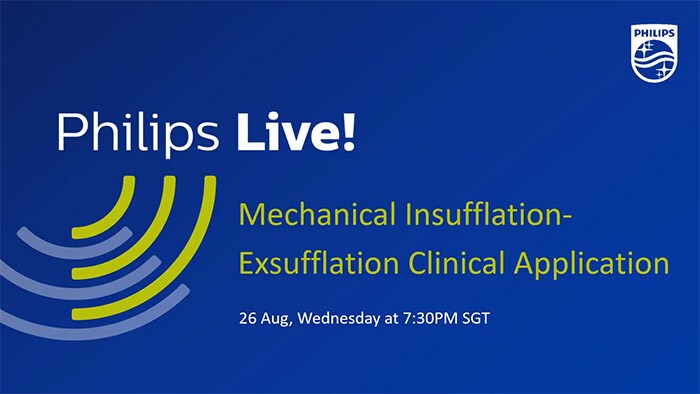Philips Sleep and Respiratory Care hosted the “Mechanical Insufflation-Exsufflation Clinical Application” webinar on Wednesday, 26 Aug 2020, where Associate Professor Amanda Piper shared her insights on MIE principles, clinical applications and benefits. Followed by panel session with Dr. Anitta, Dr. Chan Yeow, Associate Professor Napplika and Professor Chun Pan where the experts shared their MIE cough assist experiences.
Assisted cough therapy is critical to achieve maximum insufflation of the lungs and increase the expiratory flow in respiratory care of patients with ineffective cough. Mechanical insufflation-exsufflation (MIE) is a cough assist device that applies positive pressure to inflate the lungs gradually (insufflation), followed by an immediate switch to negative pressure which produces a rapid exhalation (exsufflation). This helps to increase expiratory flows for the effective removal of secretions in airways. The use of MIE has been well recommended in international guidelines for the management of neuromuscular disorders (NMD). MIE is mostly used for NMD patients with peak cough flows (PCF) ranging from 160L/min to 270L/min when other techniques are not effective. This range is inferred from patients who are weaned from mechanical ventilation, whereby a successful extubation requires a minimal PCF of 160L/min. Another study found that patients with PCF of at least 270L/min were unlikely to develop acute respiratory distress during periods of respiratory-tract infections. In individuals with PCF within this range, MIE helps by reducing reintubation and mortality risks. Several clinical data have established the benefits of MIE physiologically and in different clinical contexts like acute care, intensive care or home-based settings. However, there is a wide variation in how the therapy is set-up and used.
Benefits of MI-E
Physiological
Clinical settings
Acute care
Intensive care
Home-based
In the case of a COVID-19-induced acute respiratory distress syndrome (ARDS) patient, Professor Chun Pan demonstrated that MIE was used as an adjuvant support alongside mechanical ventilation and post-extubation. This was done primarily to assist the patient’s cough after being weaned from sedatives and neuromuscular-blocking drugs. The use of MIE has been found to achieve slight improvements in the expiratory peak flows, and the patient was subsequently discharged. Despite the apparent benefits of MIE in patients with NMD, careful assessment of the patient’s clinical representation is required before adopting MIE as a cough assist device. MIE is not an ideal treatment strategy for patients with significant lung diseases such as bronchiectasis, chronic obstructive pulmonary disease, pneumothorax, and bullous emphysema. Other clinical conditions not in favour of MIE include bulbar amyotrophic lateral sclerosis, haemodynamic instability, elevated intracranial pressure and nausea. Holistically, MIE has an established role in the respiratory care of NMD patients but more can be done to improve its effectiveness. More research could be directed towards underlying factors such as oscillations during the insufflation and exsufflation phases in MIE application, patient and carer training, adherence to MIE use and monitoring the effectiveness of MIE in patients with progressive disorders. Long-term studies on these issues potentially bring forth insights critical to boost the quality of life and survival in MIE-dependent patients.
With over 40 years of expertise behind our ventilation portfolio, Philips has all the tools to help you with quality ventilatory care.
Our ventilators solution has a complete set of patient-focused components and data connectivity to give you the information you need across the care journey to help you make your clinical decisions.
Our comprehensive range of care solutions

